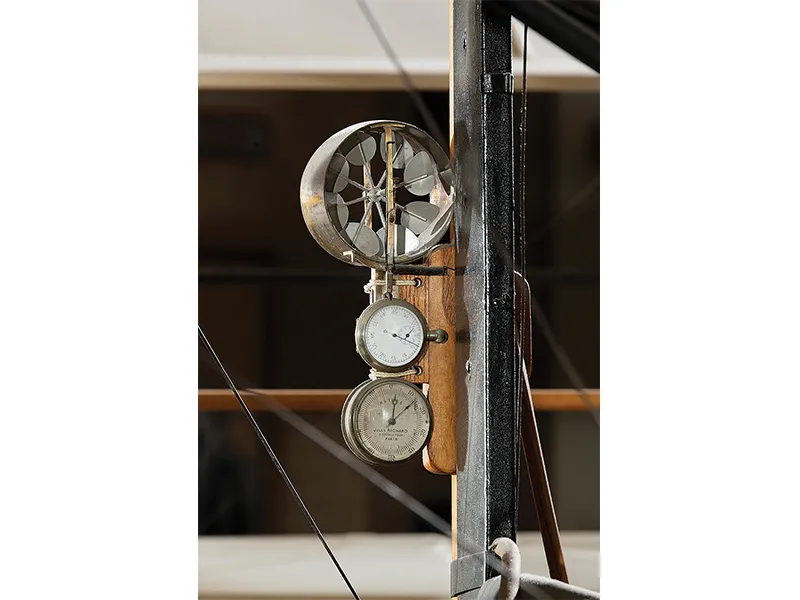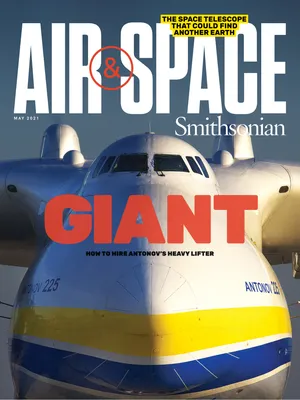The Wright Brothers & The Invention of the Aerial Age
The National Air and Space Museum revamps its exhibit on the birth of flight.
/https://tf-cmsv2-smithsonianmag-media.s3.amazonaws.com/filer/1a/60/1a600aa1-36dd-4f20-bb35-643c1dbf1383/12s_am2021_wright_nasm2013-00427_liveedit.jpg)
There are a handful of artifacts in the Smithsonian Institution that I call “signature Smithsonian objects.” One-of-a-kind objects, intimately associated with the Smithsonian, that visitors feel they must see on their tour of the museums. Among others, they include the flag that inspired the national anthem, the Star-Spangled Banner; the Hope diamond; the ruby slippers from the Wizard of Oz, and the Apollo 11 Command Module Columbia. Among the signature Smithsonian objects that hundreds of millions of visitors have come to experience in person is the original 1903 Wright Flyer, the actual airplane that made those historic first flights at Kitty Hawk. It is a spectacular artifact in every respect. Aesthetically, it is a beautiful thing, with its graceful lines and economical design. As a piece of engineering, it is meticulously thought through in every detail. As a cultural icon, it represents a pivotal step in the creation of our modern world and humanity’s need to achieve and explore. If an inanimate object can have charisma, the Wright Flyer has certainly got it. When visitors stand before it, and grasp that this is the airplane that started it all, the machine that gave us our wings and launched us on a journey high above the Earth and even beyond the solar system, they are awed by what this artifact embodies. When the Wright Flyer was first put on public display at the Smithsonian in 1948, a dignitary in attendance eloquently captured its significance when he remarked it was “a little as if we had before us the original wheel.”
When the National Air and Space Museum completes its transformation with all new exhibition galleries, the Wright Flyer will still be the centerpiece of the Museum’s collection and at the heart of the story of flight the Museum tells. But this extraordinary artifact will be displayed in a new, more prominent location, and in a beautiful redesigned exhibition. Visitors will be just a few feet from the Wright Flyer, able to intimately examine this world-changing invention and experience the excitement of being in its presence.
/https://tf-cmsv2-smithsonianmag-media.s3.amazonaws.com/filer/cf/8e/cf8e6216-38ec-4bad-b056-9f16736631fb/12j_am2021_rendering0382-107-wb_95_live.jpg)
But there is more to the Wright exhibition than seeing the first airplane to fly. When you visit the redesigned gallery, The Wright Brothers & the Invention of the Aerial Age, you will also see up close the world of Wilbur and Orville Wright, and you will follow them on their inventive journey. Through artifacts from their youth and their days as printers and bicycle mechanics, you learn who the Wright brothers really were and what about them enabled Wilbur and Orville to achieve success where others had failed. With the tools used to design and build the first airplane, each critical step of their inventive process is revealed, right up to those breathtaking moments when the Wright Flyer took to the air and the world changed.
The Wright achievement is so much more than those short flights on December 17, 1903. The Wright Flyer is truly a seminal object. Every airplane that followed incorporates its essential design elements. The Wright brothers didn’t simply build a craft to get off the ground. They designed a flying machine that could evolve and become the almost magical means of transportation we fly today. Their pioneering approach to aircraft design is still the foundation of modern aeronautical engineering.
/https://tf-cmsv2-smithsonianmag-media.s3.amazonaws.com/filer/dc/08/dc080014-aa5d-4be0-bcab-d2efe2a38f2a/12f_am2021_firstairdelivery_peter5842h_live.jpg)
The Wright Brothers & the Invention of the Aerial Age not only demonstrates the relevance of the Wright brothers for our own time but also richly portrays how the invention of the airplane was received and understood in the Wrights’ day. Within a decade of the triumph at Kitty Hawk, it was apparent that the airplane was no mere technical curiosity. Business leaders, the military, and popular culture all recognized the revolutionary meaning of human flight realized, and all embraced the new aerial age. The gallery presents dozens of unique, diverse artifacts and artworks that colorfully illustrate the fascination with flight that took hold in the years just after the Wrights showed the world how to fly. The exhibition features rare photography depicting airplanes over famous landmarks and performing for the public, demonstrating how quickly the sight of an airplane was becoming part of our collective experience. The invention of the airplane was coincident with the birth of the modern art movement. Avant garde artists of the time frequently adopted flight as a theme of their work, and several of their creations will be on view in the exhibition. Motion pictures, another technology that would powerfully influence the 20th century, also emerged with the airplane. The gallery screens one of the earliest dramatic films with aviation as its subject matter.
By the beginning of World War I in 1914, the airplane had not only become a reality, but had created a new aerial age. Human imagination now had wings. The Wright Brothers & the Invention of the Aerial Age brings to life the inspiring story of Wilbur and Orville Wright, who showed us that individuals really can change the world.
Wright Brothers & the Invention of the Aerial Age is made possible by the generous support of David M. Rubenstein and Frederick and Barbara Clark Telling.


